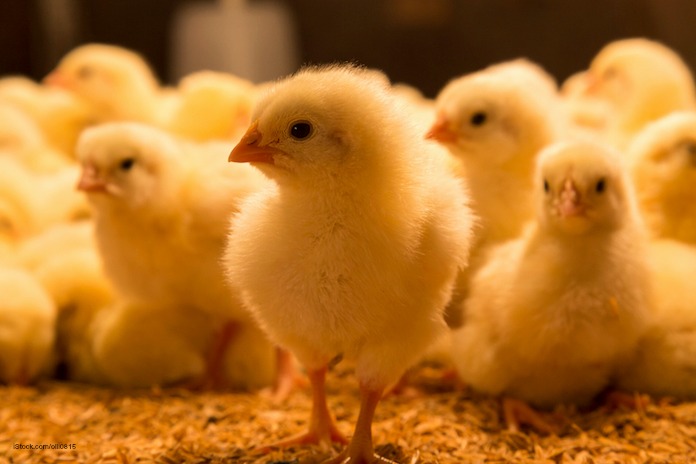The Centers for Disease Control and Prevention (CDC) issued their final update on eight multistate outbreaks of Salmonella infections linked to live poultry in backyard blocks. Those outbreaks are over, but the government says that people can still contract Salmonella from live poultry.

This year, 2016, saw the largest number of illnesses linked to contact with backyard poultry ever recorded. The CDC, multiple states, and the USDA’s Animal and Plant Health Inspection Service investigated eight separate multistate outbreaks of human Salmonella infections linked to contact with live poultry in backyard flocks.
In those eight outbreaks, 895 people were sickened in 48 states. And since the multiplier for Salmonella infections is 30.3, since most people with this illness do not go to a doctor, that means there may be more than 27,000 people sickened in these eight outbreaks.
In those outbreaks, 209 ill persons were hospitalized, and three deaths were reported. The Salmonella infection was considered to be a cause of death for one person in Mississippi. The two people who died in Kentucky and New Jersey were sick with Salmonella, but the infection was not considered to be a cause of death.
Unfortunately, 254, or 28%, of ill persons were children five years old or younger. Public health officials warn parents not to let children younger than five years handle or touch chicks, ducklings, or live poultry without adult supervision.
The illness onset dates for these eight outbreaks ranged from January 4, 2016 to September 10, 2016. Ill persons ranged in age from less than 1 year to 206 with a median age of 27. Epidemiologic, traceback, and laboratory findings linked the eight outbreaks to contact with live poultry, such as chicks and ducklings, sourced from multiple hatcheries around the country.
Ill persons reported purchasing live baby poultry from several suppliers, including feed supply stores, internet sites, hatcheries, and friends in multiple states. They bought the birds to produce eggs, learn about agriculture, have a hobby, keep as pets, or give as Easter gifts.
In Outbreak 1, 249 people were infected with the outbreak strain of Salmonella Enteritidis in 48 states. Of the 242 people interviewed, 240, or 99% reported contact with live poultry the week before they got sick.
In Outbreak 2, a total of 25 people infected with the outbreak strain of Salmonella Muenster were reported in eight states. Forty percent of those sickened were hospitalized in that outbreak.
Outbreak 3 was caused by Salmonella Hadar. Eighty-six people were sickened in 29 states. Thirty-eight percent were hospitalized in that outbreak.
Salmonella Indiana was the cause of Outbreak 4. A total of 110 people in 24 states were sickened in that outbreak, with 28% of ill persons hospitalized.
Outbreak 5 was caused by Salmonella Mbandaka. Forty-six people in 20 states were sickened, and 28% were hospitalized.
In Outbreak 6, 219 people were sickened with Salmonella Infantis in 39 states. In that outbreak, 27% of patients were hospitalized.
Outbreak 7 was caused by Salmonella Braenderup. A total of l129 people in 25 states were sickened in that outbreak.
And finally, another strain of Salmonella Infantis sickened 31 people in 16 states in Outbreak 8. Thirty-three percent of ill persons were hospitalized in that outbreak.
The CDC says that contact with live poultry and their environment can make people sick. These birds can carry Salmonella bacteria but still appear healthy and clean. If you choose to have backyard poultry, follow steps to keep yourself and family free from illness.
Always wash your hands with soap and water after handling live poultry or anything in the area where they live and roam. Wash your hands after handling clothes and shoes that have touched live poultry. Adults should supervise hand washing for young children. Do not leave young children alone with poultry. Do not hug or kiss the birds, touch your mouth, or eat or drink around live poultry.
Children younger than 5, adults older than 65, and people with weakened immune systems should not handle or touch chicks, ducklings, or other live poultry. People in those groups are more likely to have a serious illness from a Salmonella infection.
Don’t let live poultry inside the house, in bathrooms, or especially in areas were food or drink is prepared, served, or stored, such as kitchens or outdoor patios.
The symptoms of a Salmonella infection include nausea, vomiting, abdominal pain, diarrhea that may be bloody, fever, chills, headache, and muscle pains. These symptoms usually begin six hours to three days after exposure to the bacteria. Most people recover on their own after this illness, but some must be hospitalized because their symptoms are so severe. And some people can develop complications years after a Salmonella infection, including reactive arthritis, irritable bowel syndrome, and high blood pressure.




